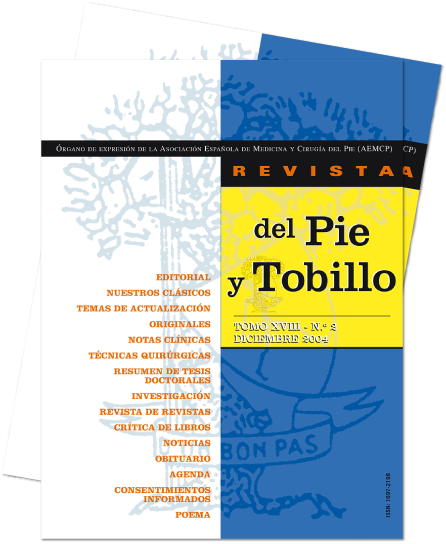Resumen:
Objetivo: obtener una fusión tibio-astrágalo-calcánea adecuada con clavo de revisión, un pie plantígrado sin dolor, mínimas complicaciones y rehabilitación temprana en pacientes con alteraciones neuromusculares.
Material y métodos: se realizó un estudio prospectivo, longitudinal, descriptivo, entre diciembre de 2002 y enero de 2004, pacientes con inestabilidad de tobillo, deformidad severa, dolor, artrosis de tobillo con una alteración neuromuscular; se excluyeron pacientes con antecedentes de fractura, diabetes mellitus. Se realizó artrodesis tibio-astrágalo-calcánea con clavo centromedular retrógrado. Se obtuvieron 44 pacientes con pie afectado: 24 izquierdo, 18 derecho, 1 bilateral; sexo femenino 31 (54%), 13 (40,9%) masculino; patología frecuente: secuelas de poliomielitis 17 (38,63%).
Resultados: escala de visión análoga fue de 8,4 ± 2 en relación postquirúrgica de 5,5 ± 2. Escala de AOFAS sin dolor 93%, función adecuada y alineación 93%, complicaciones, dolor del talón en un paciente, otro paciente con deformidad en valgo, y otro con ruptura de material.
Discusión: el clavo centromedular de revisión para artrodesis tibio-astrágalo-calcánea provee una fusión efectiva y complicaciones mínimas.
Conclusión el clavo centromedular de revisión es efectivo en pacientes con artrosis no traumática, observando a corto plazo una mejor calidad de vida, más independiente, con disminución de complicaciones, incorporación a sus actividades cotidianas con menor tiempo de inmovilización y temprana rehabilitación.
Abstract:
Aim: to achieve an adequate tibio-talo-calcaneal arthrodesis with a revision nail, a painless plantigrade foot, minimal complications and early rehabilitation in patients with neuromuscular disorders.
Material and methods: a prospective, longitudinal and descriptive study ranging from December 2002 to January 2004 was carried out; the study population were 44 patients of both genders [31 (54%) females, 13 (40.9%) males] aged 22 to 69 years, with ankle instability, severe deformity, pain, ankle osteoarthritis and neuromusccular disorders. The exclusion criteria were a history of previous fracture and diabetes mellitus. A tibio-talo-calcaneal arthrodesis with retrograde revision nail was performed in all cases, with partial weight-bearing at the third week and total weight-bearing at the eighth week. Twenty-four cases were left-sided, 18 were right-sided and one was bilateral. The most frequent concomitant condition was polyomyelitic sequelae (17 cases, or 38.63%).
Results: the mean VAS score was 8.4 ± 2 before and 5.5 ± 2 after surgery. In the AOFAS rating scale, 93% of the patients had no pain and 93% had adequate function. The complications were heel pain in one case, valgus deformity in one case, and material breakage in one case.
Discussion: achieving optimal management of ankle osteoarthritis secondary to a neuromuscular disorder constitutes a challenge for the orthopaedic surgeon. The centromedullary revision nail for tibio-talo-calcaneal arthrodesis provides adequate fusion with minimal complications.
Conclusions: the centromedullary revision nail is an effective option for patients with non-traumatic ankle osteoarthritis, providing better quality of life, more independence, less complications and earlier return to everyday activities, a shorter immobilisation period and quicker recovery.





